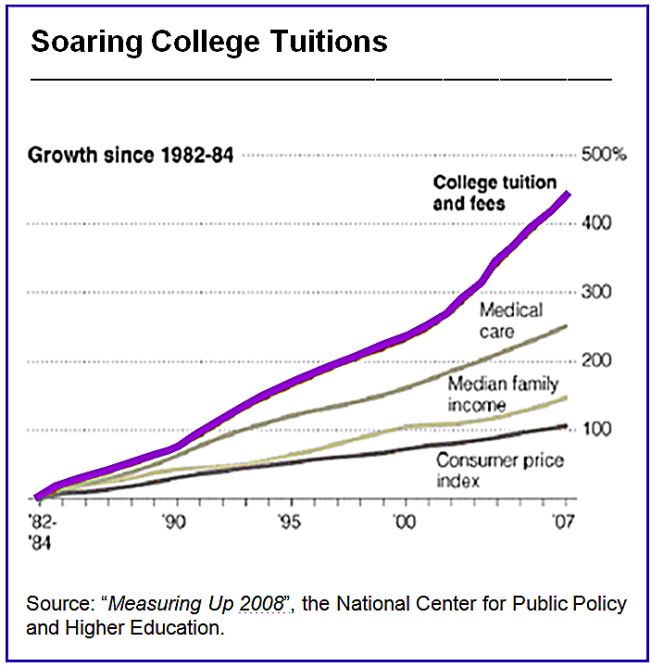
[Don’t blame me…]
From early 2011 through 2012, a time-frame roughly corresponding with the emergence of the Occupy protests, I noticed a series of articles appearing in the mainstream press sharing a common theme: recent college graduates were finding the job search far more difficult than they expected, with few finding employment in the their major and many bearing the additional burden of college debt. Some questioned the utility of their degrees. The general response of the graduates interviewed was: “what happened? We expected jobs when we finished college.”
It was telling that most of the those who expected employment were graduates of the Ivy League. The phenomena of unemployment after graduation has been a problem in this country for decades. The idea of education as an “investment” rather than an “expense” has been laid bare by the high levels of debt often required to attain a BA and the declining likelihood that the BA will lead to employment.
More recently, a number of articles appeared in the Chronicle of Higher Education, The New Republic, The Claremont Review, and elsewhere lamenting the decline of the humanities. Here is a portion of TNR’s Leon Wieseltier commencement address to the Brandeis University class of 2013:
For decades now in America we have been witnessing a steady and sickening denigration of humanistic understanding and humanistic method…The technological mentality that has become the American worldview instructs us to prefer practical questions to questions of meaning – to ask of things not if they are true or false, or good or evil, but how they work. Our reason has become an instrumental reason, and is no longer the reason of the philosophers, with its ancient magnitude of intellectual ambition, its belief that the proper subjects of human thought are the largest subjects, and that the mind, in one way or another, can penetrate to the very principles of natural life and human life.
This post addresses three interrelated concerns: the decline of the Humanities and Liberal Arts (HALA), the increasing cost of education and some possible solutions. I begin with a somewhat paradoxical and undoubtedly controversial thesis: the Humanities and Social Sciences are in crisis because too many people pursue these fields of study rather than too few.

The Burden of Increasing Cost
In general, subsidizing consumption of a good or service leads directly to increased consumption of that good or service, which, in turn, leads increase in price. The idea that an infusion of federal dollars into the education sector is fueling price increases is known as the Bennett Hypothesis, after former Secretary of Education William Bennett. Bennett’s hypothesis is based on a simple understanding of the law of demand. And he was quick to point out that he did not think federal aid was the sole cause of the increase. However, there was a strong correlation. Nevertheless, his supporters often neglect other basic principles of micro-economics, including if the supply of something increases over time in pace with demand, the cost will not increase as well as the possibility that demand for education may be inelastic. That is, demand is not impacted by price.
Other contributing factors include increased administration costs and real estate expansion, plant and student housing upgrades, and the cost of college sports teams.
I am not an economist, but there are two factors at play here: how valuable is a humanities education? And how much does it cost? There is also the matter of tuition in relation to cost. Some Ivies, like Harvard, have increased their tuition, but they manage to keep costs down for students whose families make less than $50,000/year. In any event, the cost of higher education has increased while the economic value of many degrees has declined.
Why Are the Humanities in Decline?
As the quantity of something increases—and especially as its quality decreases—that leads to a service or commodity becoming less dear, less valued, and less prestigious. Writing in the Claremont Review, William Voegeli notes:
College was indeed a good investment of time and money in 1960, when only one out of every 13 American adults had a bachelor’s degree.
Now that the day is at hand when one out of every three will have a B.A., the calculus is different. Going to college is becoming one of those good ideas that turns into a bad idea when too many other people have the same idea—like leaving town early before a three-day weekend to avoid the traffic jam, thereby helping cause and becoming part of the traffic jam you left to avoid.
I recognize a decline in the prominence and stature of the humanities. Only it is not a relatively recent development as progressives argue or a product of 1960s efforts to replace a Western canon with something else as conservatives contend. Instead, the roots of our educational malaise can be traced back to the movement for compulsory high school and the democratization of college. Our crisis is one of oversupply. We have too many over-educated people in the US.
The truth is we (institutions of higher education) have been graduating too many Humanities and Liberal Arts majors since the 1980s. The vast majority of HALA graduates back then were not getting employed in their field of study. We (society) continued saying: “go to college. Education is the way to succeed.” But we were never honest about the type of education that was necessary to get ahead or the massive debt that many students would accumulate in pursuit of marginally beneficial degrees.
But what about the employers who constantly tell us they are not able to hire domestic graduates with the skill sets they are looking for? What about all these people with BAs who are unemployed or underemployed?
Thomas Jefferson was an early advocate of a two-tier educational system in the United States, with separate tracks for the laboring and elite classes. His vision largely held for over a century and a half. Before WWI, fewer than 15% of the population graduated high school and approximately 3% above the age of 25 held a bachelors degree. BA degrees in History, English, Foreign Languages and the Arts were a sign of membership in an intellectual elite. Liberal-arts education emphasized a Western canon of thought, politics, society and culture with a normative white, male, heterosexual.
Much of this elite nature of education was challenged by the Left. The Left fought for the democratization of education—more getting into college and more receiving degrees—as well as a decline of admissions standards to supposedly allow for more diversity and finally—via various forms of identity politics—a tremendous expansion of interdisciplinary “studies” programs that were openly hostile of the Western canon. Viewed in this light, conservatives claim it is not surprising that the Humanities have underwent a decline. Today, rather than a sign of erudition and familiarity with a common core of knowledge, a BA in the humanities is more likely to have a strong critique of Western imperialism and the supposed ills of “globalization” and a weak understanding of Western thought, art and culture.
While I share the conservatives malaise, the reason students who graduated high school in the 1920s were more knowledgeable than those of today concerns more than curriculum, it is closely related to the instigation of compulsory high school education. In rural areas it was common for males to end their formal education when they were strong enough to work on family farms that lacked a lot of machinery. That meant elementary school for most. The level of education was slightly higher in cities, but not much. It was not until the post-WWII era that educational opportunity was broadly expanded
We are not going back to the Jeffersonian model or the Fordist ideal of the production line. The nature of employment has changed. But do these jobs require bachelor’s degrees? One liberal economist notes:
Very few of those occupations require college in the sense that 90+% of people who pursue that occupation will benefit from having learned about it in college. But my guess would be that more than a few of these occupations “require” college in the sense that employers expect that applicants will have a BA. And this is our problem. A “Diagnostic Medical Sonographer” is a highly-skilled job that doesn’t require college training in the sense that you can learn everything you need to do the job in a manner of months. But many colleges offer programs to help you become a Diagnostic Medical Sonographer. And when you compare unemployment rates for college graduates and non-college graduates, you see why someone might want to go to college to become a Diagnostic Medical Sonographer even if it means taking on huge, unnecessary debt. And once there are enough college graduates who can become Diagnostic Medical Sonographers, you can see why employers would rationally toss out of the pile any resumes that don’t have a college degree on them.

[How do I operate this thing?]
Some Possible Solutions
In conclusion I would like to mention some possible solutions to these problems. I am restricting these to higher education because that is my field. I realize they are drastic, even unfair. Do not take this as a policy blueprint and I do not expect those adversely impacted to agree with these recommendations all I ask is an honest evaluation.
The first thing that needs to happen if we in the Humanities want the stature of our work and research to increase is our schools need to be more restrictive. We need to accept and graduate fewer BAs, MAs and PhDs in History, Sociology, or Political Science, for example. Outside of the institutions, federal assistance for the non-poor should be extremely limited. We should not be subsidizing the sons and daughters of the managerial class to “find themselves” or otherwise extend their adolescence. The vast majority of funding for undergraduate students should go to the STEM majors: Science, Technology, Engineering, and Mathematics and others who are pursuing courses of study that have a greater likelihood of gainful employment.
We need to be more supportive of students who display no interest in HALA and little in a BA. AA programs in engineering and science are often a perfect match for students with little interest in higher education and employers who need a workforce skilled in higher-level quantitative reasoning and an ability to communicate complex projects clearly and succinctly. This would mean increasing funding to community colleges and other two-year schools and retooling them for the twenty-first century. Making them more like Germany’s Fachhochschulen and less stepping-stones to the supposed “real” degree, which for most remains the BA.
Think about this: we would have more of the population getting educated for less money in less time, graduating with the skills that employers actually need. Instead of the situation where we are now, where we keep turning out unemployable twenty-something who are 100k in debt and wonder: “how did this happen to me? I did the right thing. I went to college.”
Telling teens to “just get the BA” is not working when over half never finish. From my close to ten years of teaching I can say fifty percent should not be in class in the first place. Douglas Murray opines, “even though college has been dumbed down, it is still too intellectually demanding for a large majority of students, in an age when about 50 percent of all high school graduates are heading to four-year colleges the next fall. The result is lots of failure”and:
The acceptable excuses for not going to college have dried up. The more people who go to college, the more stigmatizing the failure to complete college becomes. Today, if you do not get a BA, many people assume it is because you are too dumb or too lazy. Face it: To say “I’m just a high school graduate” as of 2008 is to label oneself in some important sense as a second-class citizen. No amount of protestations of egalitarianism by people who like the current system (i.e., people who do well in an academic setting) will change that reality-a reality fostered by a piece of paper that for most students in most majors is close to meaningless.
We shouldn’t aim for more college grads or fewer. The aim should be a comprehensive education system where every American can find a post secondary program to fit their needs; and for them to feel free to do so without experiencing a decline in their social capital. That’s bigger than an ed or a policy problem. This is a social/cultural issue.
We are missing an important component of the jobs discussion and that is, it is not so much that America lacks good jobs–we hear all the time from companies that want to fill jobs but lack qualified applicants–but that American youth are increasingly unemployable. Significant percentages of students are graduating high school without the ability to construct a well-written paragraph, let alone think critically. The National Assessment of Educational Progress estimates close to half are not prepared for college-level reading and a third are functionally illiterate. Even for those who do well, the skill set that most possess after a high school education is inadequate to land these good-paying jobs so some level of college is necessary.
Not necessarily at the BA level. In fact, our educational system over-emphasizes the BA. A large measure of this is market-driven, employers demand a BA and so we have applicants for BA programs. But when you look at what our students are graduating with (in terms of degrees) and the skills that employers are looking for, there is a huge disconnect. So what are these skills?
Our problem, generally as a society and specifically in regards to education, is we have prioritized the liberal arts degree over the technical degree for a variety of reasons. Part of this relates to the elite roots of a classical liberal education as opposed to the more plebian origins of technical-colleges. In other words, there is a class dimension. The assumption being a degree in the liberal arts was a pathway to the middle-class if not a certificate of bourgeois-ness. There was also a racial dimension. Urban Blacks and Latinos argued they were being tracked into industrial occupations and away from more intellectual and critical endeavors. All of this is part of our past. But it does not help explain how to fix things now.
My first proposal is dramatically reducing federal student aid for four-year college degrees in the fine arts, social sciences, and humanities primarily through a gradual elimination of the federal college loan system. This would have a double-impact in the short term in addition to a more longer term result. The dual impact would be reducing student enrollment–which would be the focus of the progressive media and the educational establishments–as well as significantly reducing costs. As others across the political spectrum have pointed out, the tremendous flows of capital from the federal government to higher education have contributed to skyrocketing tuition costs. The more longer term impact would be as the supply of people with BAs declined, the social value of the social science and humanities BA would increase.
My second suggestion is increasing funding for STEM especially at the AA level at city and community colleges: fully paid scholarships for students willing to complete these two-year degrees in the sciences and math, regardless of whether they want to complete a four-year degree.
These two changes in the way we think about and fund education would have far-reaching impacts. On the one hand, the notion that every young adult needs a liberal arts education to be successful would decrease. And we would be doing our youth a service by giving them an opportunity to start their adult lives free of debt and without a close to worthless degree in the liberal arts.






























